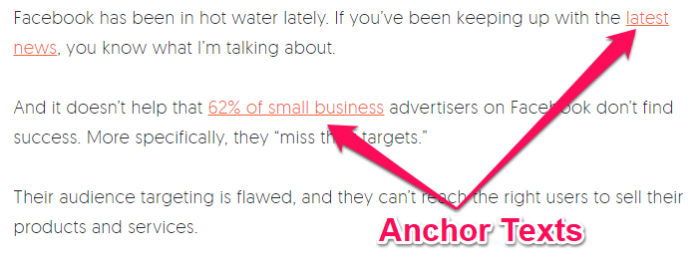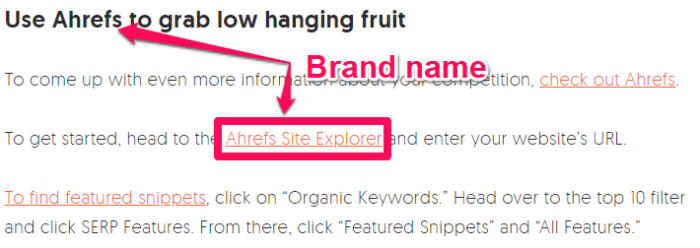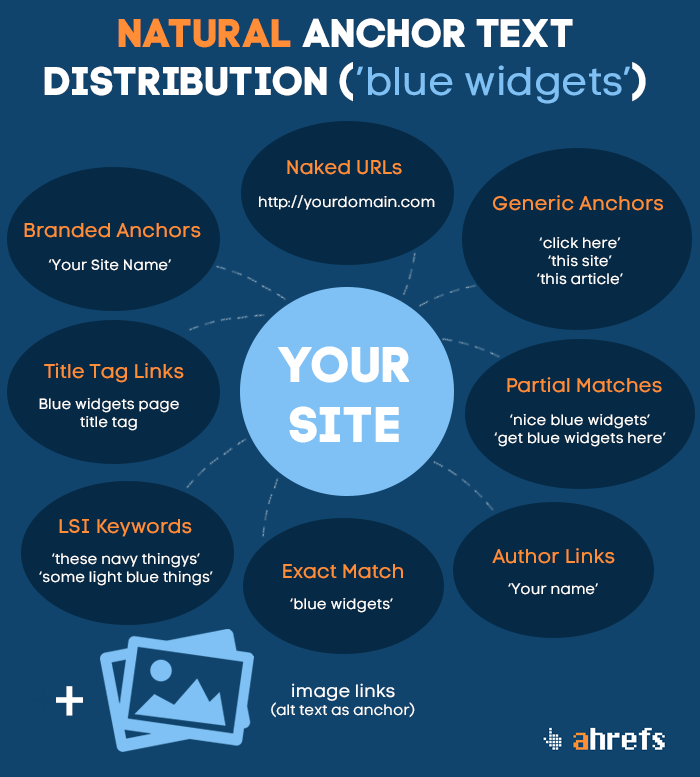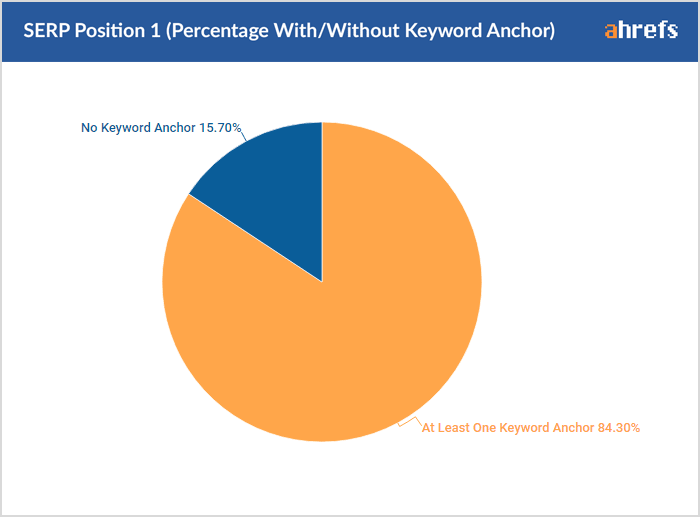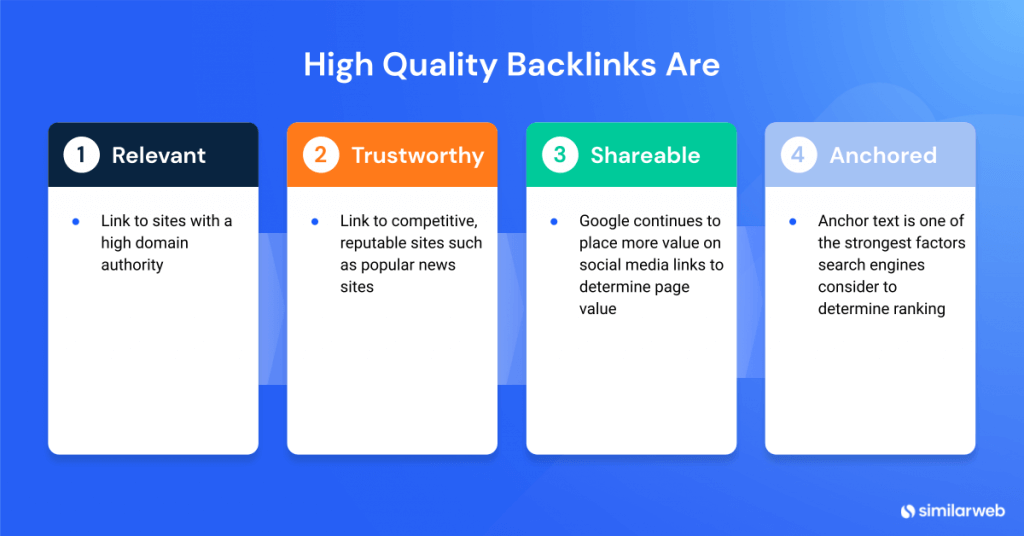
Step into the exciting world of SEO in 2023, where optimizing anchor text is central to boosting your search engine ranking. Think of anchor text as a helpful guide, gently leading users to your valuable content. Our guide explores the art of mastering anchor text, ensuring your website and content become more visible.
Prepare to learn how to make your links stand out amidst search results. Whether you’re new to the online world or familiar with SEO, let’s uncover techniques that give your anchor text a special touch, connecting your content with the right people when they need it most.
Discover methods that add a unique quality to your anchor text, linking your content with the right audience precisely when they need it.
Understanding Anchor Text
Definition of Anchor Text and Its Role in Hyperlinking
Anchor text is referred to as the text you can click on in a hyperlink, working like a label for the linked webpage. In the picture above, “latest news” and “62% of small businesses” are anchor phrases.
It’s super important for linking because it guides users and search engines to the linked page’s content. When people see the anchor text, like a sneak peek, they decide whether to click the link.
Moreover, anchor text impacts a site’s position in search results. It assists search engines in comprehending the content and significance of the linked page.
Keep anchor text short and simple. Avoid complex phrases. It should tell readers about the linked site and encourage them to click.
In SEO, anchor text is a big deal. It improves user experience and makes your website more visible. By adjusting anchor text, you aid users and search engines in better comprehending your content, resulting in improved search rankings and a more captivating online experience.
Types of Anchor Text
Exact Match Anchor Text
Exact match anchor text, as the clickable text within a hyperlink, employs the specified target term or phrase. For example, if the target phrase is “top outreach agency,” the exact match anchor text would also be “top outreach agency.”
While utilizing this type of anchor text in excess might raise red flags and be perceived as over-optimization or spam, it can give search engines apparent keyword relevancy. Maintaining a natural and varied link profile while balancing precise matches and other types of anchor text is essential for improved SEO performance.
Partial Match Anchor Text
Partial match anchor text uses a variation or a portion of the target keyword or key phrase within the clickable text of a hyperlink. For example, if the target phrase is “healthy smoothie recipes,” a partial match anchor text for that term could be “delicious healthy smoothies” or “easy smoothie recipes.”
Since it strikes a balance between keyword variation and relevance, this anchor text is beneficial for SEO.
Branded Anchor Text
When using branded anchor text, the name of a website or company is utilized as the clickable text within a hyperlink. For instance, the branded anchor text “Ahrefs Site Explorer” is used in the picture above.
This anchor text depends on establishing authority, raising brand recognition, and creating brand connections with the linked content.
As per a study by Backlinko, branded anchor text is a simple — yet powerful — brand signal. Branded anchors also serve as a trust signal to search engines, showcasing the website’s legitimacy and authenticity.
Generic Anchor Text
Generic anchor text is the clickable text inside a hyperlink that uses general words or standard calls to action. A few examples are “click here,” “read more,” and “learn more.” While generic anchor text lacks keyword relevance, it drives readers to certain website actions.
It is frequently used in buttons or links that invite users to look around further or obtain more data. However, as it might appear spammy, generic anchor text should only be used occasionally. Furthermore, it doesn’t help the audience or search engines determine the subject matter of a linked website.
Naked URLs
When the entire website address is displayed in a hyperlink without any anchor text, this is referred to as a naked URL. An example of a naked URL is https://outreachcrayon.com/. Users can view the website URL they will be taken to using this direct anchor text.
Although it is easy to use, this type of anchor text is not the most effective. It is often used for content like quotes or photographs.
Naked URLs are frequently employed when referring to reputable websites or authoritative sources since they do not require keyword-rich anchor text.
The image above illustrates companies’ need for a more organic distribution for their anchor text strategy. These options employ very natural language and communicate a clear objective to search engines and your user.
The Significance of Context and Relevancy in Anchor Text
Relevance and context are very important factors in optimizing anchor text. Search engines, especially Google, prefer anchor texts that precisely match the linked site’s content.
When users click a link, appropriate anchor text ensures they find relevant and helpful content, creating a wonderful user experience. However, irrelevant anchor text can deceive site visitors and increase bounce rates, which are bad for a website’s SEO rankings.
According to research, there is a more significant likelihood that your content will rank higher if it has at least one keyword anchor that indicates relevancy. The figure above shows that at least one keyword with a relevance implication appears in 84.3% of popular Google searches.
8 Steps to Optimize Anchor Text for SEO in 2023
Follow the steps mentioned below to optimize your anchor text strategy in order to enhance your SEO performance.
1. Conduct Thorough Keyword Research
For optimal anchor text optimization, conduct thorough keyword research. Keywords are like the solid foundation of SEO. Knowing the right words for what you’re talking about and who’s reading is crucial. Use tools to find longer phrases that work as keywords, which makes your anchor text diverse and helps with SEO.
When you do thorough keyword research, you not only find the right keywords to use but also see how many other websites are using them and how many people are searching for them. It’s important to pick keywords that are not too hard to compete with but also not too easy. This way, you can plan your anchor text strategy step by step.
The best way to use keywords, like in the picture above, is:
- Look for the words people use when they search, words that might lead them to you.
- Each of these words can help your business in some way.
- Try to pick keywords that your website can show up for.
Matching your anchor text with these good keywords makes the websites you link look more related and important to search engines.
2. Opt for Natural Anchor Text Distribution
As anchor text optimization grows in SEO for 2023, keeping anchor text types balanced is essential. You can use the info above to spread out anchor text correctly. About 12% should be exact match keywords, 25% should be URLs, 17% brand names, and so on for different categories.
Search engines might get concerned if you do too much optimizing or spamming, and that could lead to getting punished.
The image above is an illustration of how keyword overuse might seem. Using keywords excessively can lead to problems, giving the impression that your website is spammy.
To achieve a balanced anchor text variety, incorporate different types such as exact matches, partial matches, brand names, simple terms, and web addresses.
When the anchor text is used naturally, it helps users by giving them content that fits the link’s purpose. This makes your links more valuable and user-friendly.
3. Optimize Internal Links with Anchor Text
Leveraging internal links with clever anchor text is an essential stage in the process of optimizing anchor text for SEO. Internal linking improves user navigation and website structure, boosting user engagement and SEO rankings.
Anchor text raises the value of a link by including keywords and information in the linking process. Google looks at more than simply AHREF tags. They check the link’s anchor text.
Well-designed internal links offer value and smooth navigation, encouraging users to explore more pages. The user experience is better when the linked sites support the anchor text, eventually increasing user retention and boosting website authority in the cutthroat SEO market.
4. Balance Anchor Text with Brand and Generic Anchors
Achieving harmony between brand and generic anchors holds paramount significance. Brand names and familiar terms introduce diversity to your link profile and heighten user engagement, fostering an enriched online journey. Concurrently, keyword-rich anchors retain their pivotal role by supplying search engines with the necessary context.
Branded anchors propel brand recognition and trust, elevating credibility among users and search algorithms. On the flip side, straightforward generic anchors like “click here” facilitate seamless navigation, leading visitors across your website effortlessly.
By tactfully dispersing varying anchor text types, a genuine link profile flourishes, averting over-optimization pitfalls. This well-balanced technique not only cultivates a user-friendly digital atmosphere but also signifies to search engines the presence of top-tier content. In the intricate landscape of SEO, finding equilibrium among anchor text choices contributes profoundly to achieving search visibility and enhanced user experience.
5. Monitor Anchor Text Performance
In the ever-changing world of SEO, keeping an eye on how anchor text is doing is super important. By using tools like Google Search Console and analytics programs, website owners can see how changing anchor text affects their search rankings and traffic.
Looking at anchor text performance regularly helps find patterns and trends. This helps make smart changes to the anchor text plan based on data. It also helps website managers see what kinds of anchor text work best for engaging users.
By tracking how anchor text is performing, website bosses make sure the words they use match the content they’re linking to. This fits with search engines caring about relevancy and user experience. It’s like making sure the pieces of a puzzle really fit together.
6. Adapt to Mobile-First Indexing
As mobile devices claim the internet spotlight, aligning with mobile-first indexing becomes imperative for effective anchor text optimization. Given search engines’ focus on ranking mobile website versions, ensuring mobile-friendly anchor text is paramount.
Craft concise, user-friendly anchor text that resonates with mobile users. A lengthy text might hamper user experiences and impact page rankings negatively. Moreover, with the surge of voice searches, embracing natural language and conversational anchor text enhances compatibility with voice-based queries.
Adapting to mobile-first indexing ensures your anchor text strategy thrives in the mobile-driven digital landscape, maximizing user engagement and search visibility. This responsive approach cements your website’s readiness for the evolving online sphere, paving the way for effective anchor text optimization amidst the mobile revolution.
7. Earn High-Quality Backlinks with Optimized Anchor Text
Getting high-quality backlinks with well-chosen anchor text is a big part of making your anchor text work great for SEO. Backlinks from trusted and related websites are like strong signals to search engines, showing that your website is trustworthy and important.
As per the above image, a high-quality backlink is one that is relevant, trustworthy, shareable, and anchored.
When another website links to yours, consider using relevant keywords that match their content. This strengthens the link and lets search engines know that the linked information is significant.
Avoid bad links since they might harm your website and are ignored by search engines. Instead, aim for reliable, authentic links that include pertinent keywords. Your website will thus gain strength and visibility in search results.
8. Stay Abreast of SEO Trends and Algorithm Updates
If you want to maintain your competitiveness online, it is crucial to always understand how SEO trends and algorithms are evolving. You can successfully update your anchor text approach by keeping an eye on modifications to search engine algorithms.
In 2023, if you want to stay on top of the constantly evolving world of SEO, make sure to regularly check for new developments in the industry, go to SEO events, and follow reliable sources. This method enables you to keep up with ongoing SEO developments.
Although the SEO landscape is always evolving, you can improve your website’s exposure and ranks by keeping up with the most recent changes.
Conclusion
Anchor text optimization techniques develop over time.
“Organic” anchor text distribution driven by averages for a particular topic, and specifically for your competitors’ websites, plays a significant impact, although low-quality links should be avoided.
In conclusion, you must find a strategy to stay on Google’s good side. Do not specifically try to manipulate the system; it will not be successful in the long term. Instead, utilize natural anchor text and sometimes sprinkle in links that are keyword-rich to boost your ranking.

About the author: Vibhav Gaur, Business Head
Vibhav Gaur leads strategic operations and business growth at the organization. With a strong background in digital transformation and customer-focused solutions, he has helped numerous clients streamline their web presence and scale efficiently. His leadership ensures seamless execution across teams, with a commitment to delivering results and fostering innovation in every project.

